What it says on the tin. Also see me at ItMeansApricot, my personal Tumblr, and my off-Tumblr blog, A Most Beguiling Accomplishment, which has a lot more original content.All of the captions in my posts are my own work, unless otherwise noted. So please reblog, don't repost.
Don't wanna be here? Send us removal request.
Text



Song Dynasty - Women's Hanfu Layers
Please don't mind the blindingly uncoordinated colours, I tried to use contrasting colours so you can see the layers clearly ^^;;
✿ Masterlist post ✿ Discord Server




461 notes
·
View notes
Text


My cousin got married in a “Baroque/Bridgerton” theme and they had this cute photobooth at their wedding!!
Also a good excuse to wear my anglaise again hehe
46 notes
·
View notes
Text


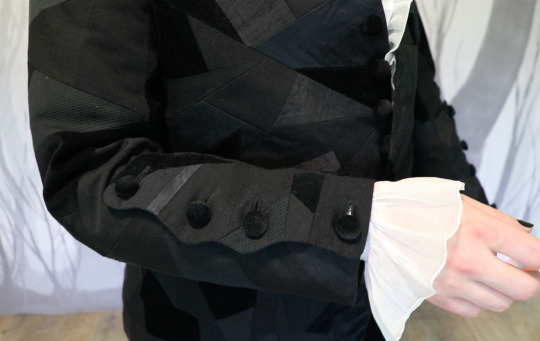
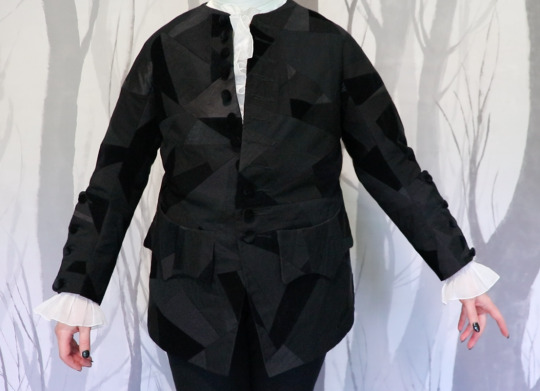
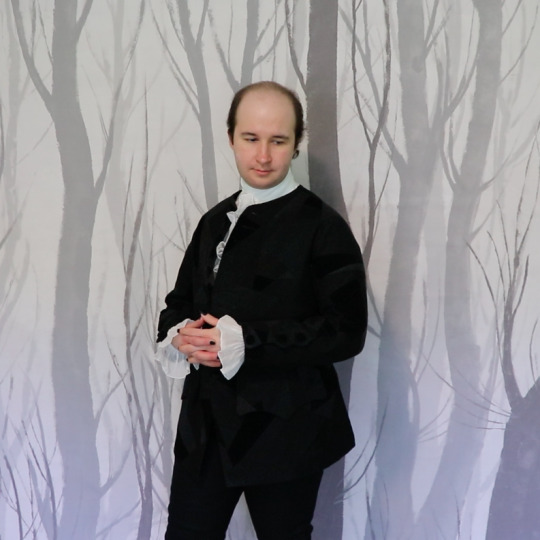

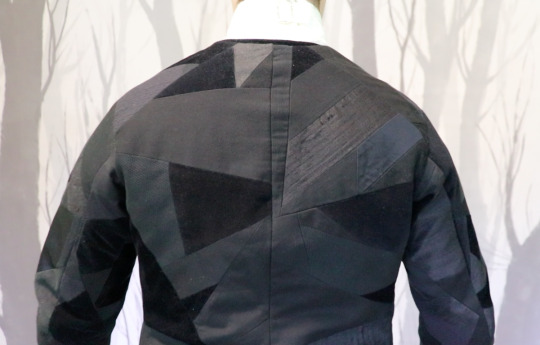


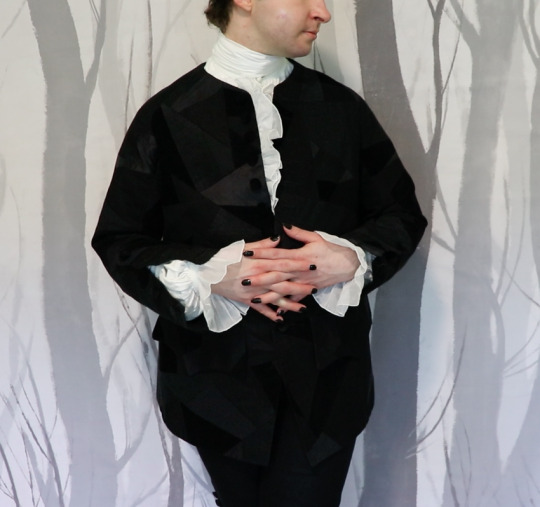
Finally got some pictures of the black patchwork jacket on me! Unfortunately the different textures didn't really show up in the full body shots on account of the background being too light, so I'll have to try some other time with a dark background.
They showed up pretty nicely in the closeups though. All the silk satin and wool and corduroy and ribbed cotton and other stuff. Mostly scraps from projects I've done over the years, plus a few little offcuts from nice black wool pants I've hemmed at work. I covered all the buttons in black cotton velvet.
This was my first time making this style of cuff and I think it turned out very nice.
789 notes
·
View notes
Text
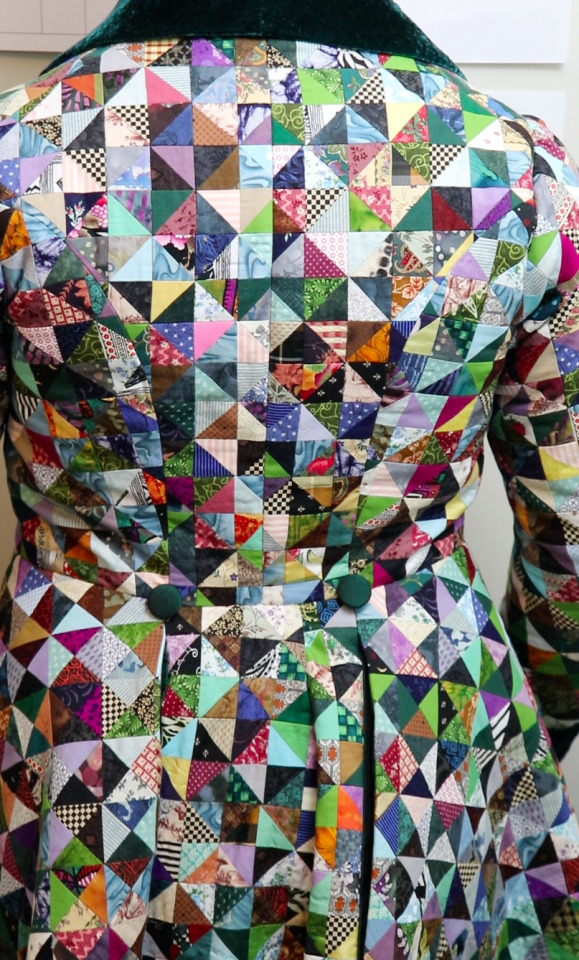
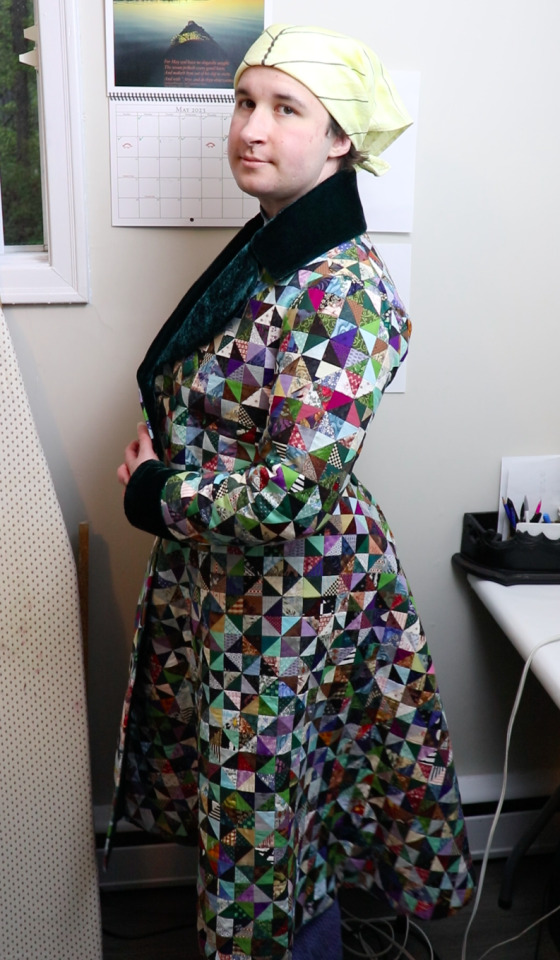
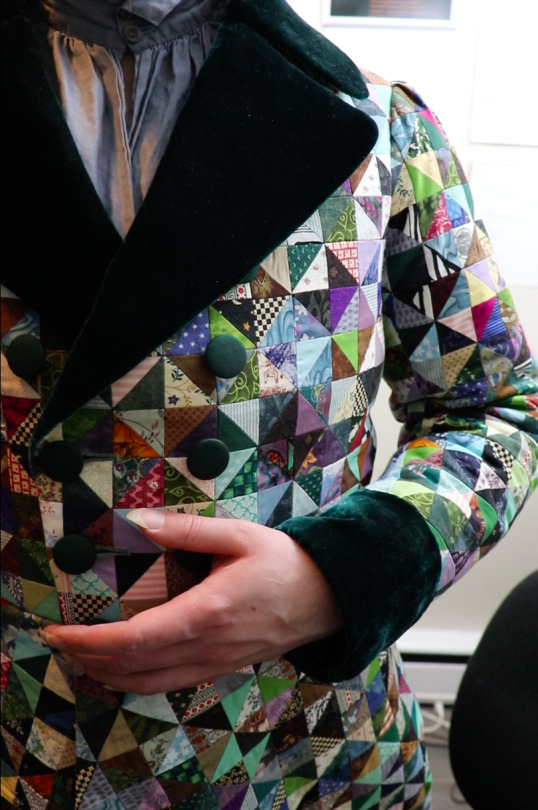
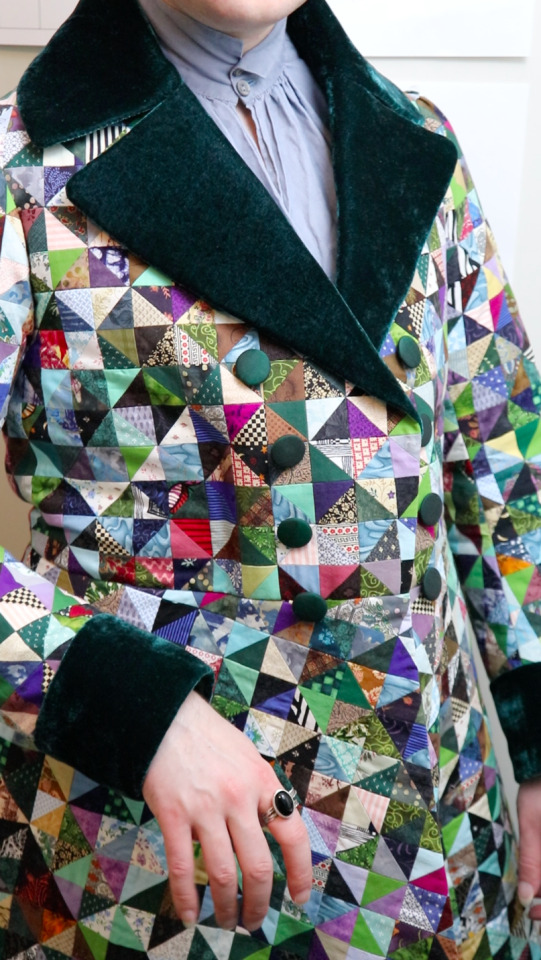


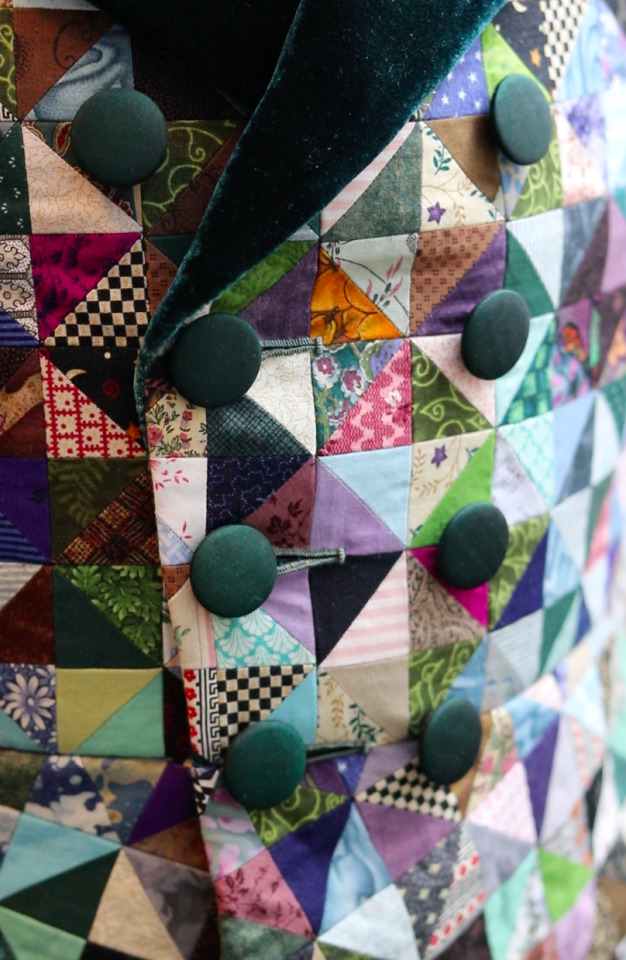

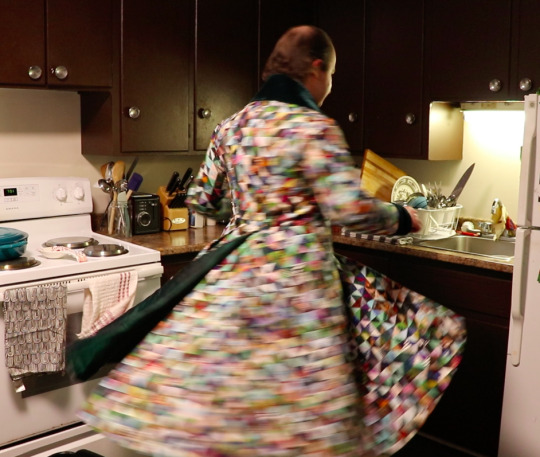
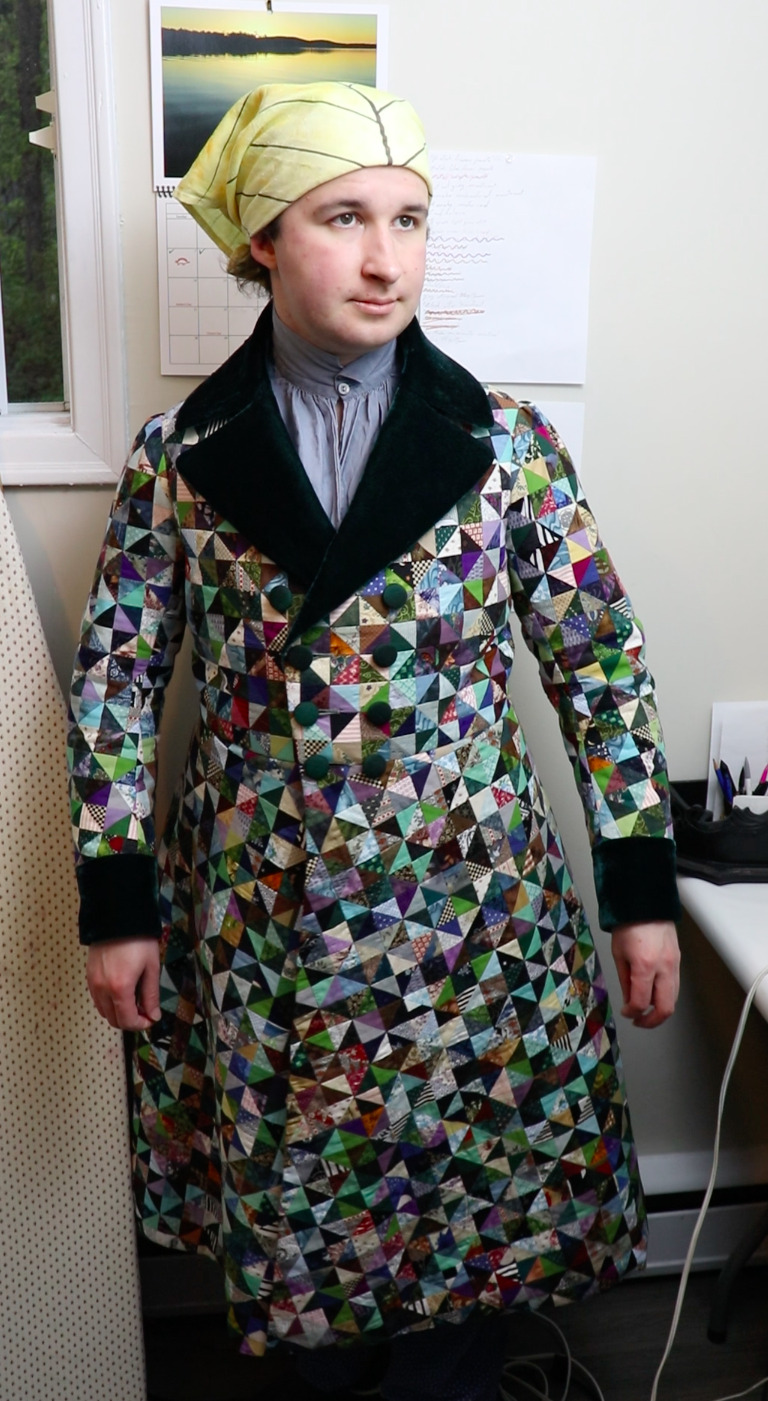

Here are some (not very good) photos of me wearing it! I'll have to get some better ones at my parents house later, because there is absolutely no good space to take photos in my apartment. I don't have any other 1830's things to go with it, and don't currently have plans to make any. I just wanted this dressing gown specifically.
Anyways! There are 6,957 triangles, all sewn together by machine, but most of the actual garment construction is by hand. The unevenness from all the patchwork seam allowances made it very fussy, and the tailoring took at least twice as long as it would have in a normal fabric. The velvet was also a challenge, being the soft drapey wobbly kind, but I managed. I accidentally made my triangles a bit smaller than the ones on the original (C. 1835, Powerhouse Museum collection.) which means there are more triangles than there had to be, but that's ok. I really enjoyed doing the patchwork, it's the most wonderfully soothing brainless task ever and I will definitely make more patchwork things.
I'm very happy with how it turned out! It's comfortable and fits pretty well, and is warm but not excessively so.
I kept timesheets for everything, and I haven't added them up yet, but once I do I'll know exactly how long all of this took.
I also filmed it, but the youtube video won't be out for quite a while, because I still have to write and record some more stuff and then edit a very very very very large amount of clips.
#daaaaaaaamn#I shared the video on bluesky and people seemed to really like it/be impressed!#reenactors#1830s#19th century
10K notes
·
View notes
Text
Yesterday I wrote an AskHistorians answer that I'd like to share with Tumblr. The question:
Is the idea of a “gay Greece” overexaggerated?
Lesbian here, and coming from a stance of curiosity and careful skepticism. Why is it believed that very many, or most, ancient Greek men were same-sex attracted (bisexual/gay)? Isn’t it true that same-sex attraction is a stable minority trait throughout time and culture? If the vast majority of men and women are heterosexual (all with the ability to engage in same-sex sex out of loneliness, etc), why is this idea so prevalent? Were the ancient pederastic poets and writers part of literary minority circles, kind of like a lot of queer people are nowadays? Looking for clarity, thank you!
My response:
This is a really interesting question, and I hope nobody minds if I approach it more from a queer theory perspective, allowing for someone more classically-minded to tackle it as a specific question of ancient Greek sexual norms with primary sources in their own answer.
The idea that "same-sex attraction is a stable minority trait" is not some kind of settled scientific fact. Sexuality is much more loosey-goosey than that! Actual individual preference with all societal baggage removed is simply and literally impossible to find -- we are shaped by the world we live in. A world where being solely attracted to "the opposite sex" is seen as the default, the norm, something that only a small number of people deviate from because they either (depending on your philosophy) were born unable to adhere to that norm or have been seduced into it blah blah. Even the concept of there being an "opposite sex" in the first place is part of a socially-constructed binary rather than something innate and biological, as there are multiple sexes when defined based on chromosomes or physicality, and multiple genders when defined based on how people see themselves. How would we define straightness absent that binary? Moreover, isn't it interesting that even people who are well-versed in the spectrum of sexuality still typically perceive "straightness" as a rigid and defined concept? Isn't it interesting that the modern cultural perception of "straightness" allows for men to have sex with other men as merely "situational homosexuality" in the absence of women, or for men to self-define as "straight" because they always top?
It's very common for people to argue that we shouldn't label historical figures as queer because they would not have understood that self-definition. It's an argument I understand, but it betrays a simplistic understanding of what "queer" means, treating it as something like a political identity today. Which, to be fair, is often how it's used colloquially. However, "queer" is an extremely useful word due to its vagueness, in comparison to pretty much all the other sexuality descriptors: "same-sex attracted" and "opposite-sex attracted" subscribe to that inaccurate binary, and "homosexual" and "heterosexual" do as well, while also being terms culturally grounded in the late nineteenth- and twentieth-century medicalization of sexuality; "gay" and "lesbian" are very specific and also quite politicized labels; "bisexual" and "pansexual" can be useful but not only also come out of a modern context but have a bunch of baggage about What This Specifically Means rooted in interpersonal conflicts within the community (we could make this even more complicated by considering "people who identify as bisexuals who identify as lesbians" but that's not what your question is remotely about); and none of this gets into the difficulties of identifying asexuality even in oneself today, let alone in people we only have records of. "Queer" is a wonderfully vague and all-encompassing term that can be used to mean "anything other than a man who is romantically and sexually attracted to women and only act on those feelings or a woman who is romantically and sexually attracted to men and only acts on those feelings", and there's a reason that it's been embraced in the fields of queer theory and queer history - it's useful specifically as a way to break out of modern paradigms.
So we go back to your original question and the issue of modern paradigms. There are people who will argue that discussing ancient Greek male sexuality in terms of queerness is wrong, because it wasn't about romance and didn't allow for any man to have a true, enduring relationship with another man. This is somewhat understandable but also misguided, and betrays a squeamishness with allowing for queerness in history. "Love between equals" simply cannot be a primary lens of understanding romantic and sexual relationships in any period in which a) people bought and sold other human beings and b) women were either literally or socially forced to marry men. If we cannot identify Greek men having sex with other men as queer because there was a required power differential and/or because it is presumed to be merely a method of sexual release, then we certainly cannot identify them as straight/heterosexual for marrying and procreating with women, a relationship with almost an equivalent power differential and typically done for the sake of making heirs. There is a massive double standard in which historical men can be called straight when they display no interest in women's lives outside of their own needs and the needs of the household, but not queer unless they actively pursue meaningful, permanent relationships with men of their own age and status.
#the responses were pretty interesting#the op turned out to be kind of an ass and probably a terf#but a lot of people simply don't have much experience in thinking about queerness like. at all#history#sexuality#queerness#queer#askhistorians
18 notes
·
View notes
Text

After three weeks of back-and-forth and a bit of confusion at the local print shop, I'm pleased to announce that June postcards for Postcard of the Month Club over on Patreon have gone out!
If you aren't a member of the PotMC tier, but would like to get this lovely group of well-dressed late-18th-century dancers anachronistically celebrating Pride, sign up before the end of the month, and they will be mailed to your home (or any address you provide me with) along with a brief handwritten note.
649 notes
·
View notes
Text




if you're looking to tablet-weave or kumihimo-braid some pride stuff, here are the options I came up with for bracelets for my husband and me. if you're on twistedthreads the name of the pattern is "ally mcbeal". go nuts
907 notes
·
View notes
Note
9 & 10 for clarence?
Oooh, thank you for asking, anon!
Describe your character's teeth.
Clarence's teeth are fine, basically, especially for a period without much orthodontia, but he notices every imperfection: his bottom front teeth overlap, one of the top incisors sticks out a little, he doesn't think his molars are fully aligned. This plagues him. He gets a bit weird about smiling in a way that shows his teeth. (Robert doesn't know all of this, he just knows that it makes him feel especially proud when he can get a real grin out of him.)
Are there any colors your character really isn't a fan of?
He's never liked vivid acid greens. He takes his job at the fabrics counter at Whitney's very seriously and does his utmost to help every customer get silk, wool, or cotton in exactly the colors that will most suit them, but he never ever recommends shades in that zone, because he doesn't believe they actually suit anyone.
ask a question!
1 note
·
View note
Text
Very willing to take questions for The Happy Secret of It All, if you've read it! And if you haven't but are curious and want to ask random questions: Patience Carmichael is in the Cinderella position, and Prince Will is her love interest.
Likewise, if you're into asking questions of characters you don't know, my current WIP is Arrow Collar Man; Robert is the protagonist and Clarence is his drag queen boyfriend.
all i do is make ask games hiiiiii
(pro tip: name some ocs in the tags when you reblog this so newcomers can ask with ease, and be sure to send an ask to the person you reblog it from!)
Has your character's worst trauma already happened, or is the worst yet to come?
How would/does your character feel about being picked up?
Does your character like candy?
Describe your character's favorite cup/glass/mug. If they don't have a specific one, make one up.
Your character has had a supremely lousy day. What do they do to cope?
Does your character get sick often?
What is/was your character's best subject in school?
Think about something traumatic that's happened to your character. How has it affected them?
Describe your character's teeth.
Are there any colors your character really isn't a fan of?
Describe a piece of clothing you have that your character would like to wear.
Describe a piece of clothing you have that your character would never wear.
What's an easy way to ruin your character's mood?
What's an easy way to cheer your character up?
Your character just woke up. What do they want right now?
Who is the most likely person to irritate your character?
What's your character like when they're nervous?
You know in cartoons when somebody has a little angel and devil on their shoulders telling them what to do? Would your character be the angel or the devil?
Is your character a picky eater?
Does your character like to argue?
What colors are most common in your character's wardrobe?
Does your character ever wear revealing clothing?
Describe your character in an unkind way, then describe them in a loving way.
Who is your character proud of?
Do people generally see your character as smart?
What's something about your character that nobody would guess by looking at them?
How much does your character talk?
Are/would your character's parents be proud of them?
How did your character's peers treat them when they were kids?
Name one (or more) of your character's favorites in any category--foods, colors, bands, movies, animals, etc.
143 notes
·
View notes
Text
I love this period. As it took me much wrangling to figure this out (since the dictionaries usually don't give this meaning), I'll share my knowledge: coulisse is a drawstring. So this chemise gown has full sleeves with drawstrings in the middle of the upper arm and at the elbow.

Journal des Dames et des Modes, Costume Parisien, 10 avril 1798, An 6, (14): Fichu-Turban semé de Paillettes, posé de coté. Manches froncées, à double Coulisse. Ceinture de Velours Noir. Collection of the Rijksmuseum, Netherlands
Standing woman with a fichu turban, covered with sequins, tilted on her head. She wears a dress with smocked sleeves. Black velvet belt. Other accessories: earring in the left ear, long gloves, fan, flat shoes with pointed toes. The print is part of the fashion magazine Journal des Dames et des Modes, published by Sellèque, Paris, 1797-1839.
52 notes
·
View notes
Text
I was angsting because due to the way Etsy weights/only counts recent reviews, my seller rating has dipped and as a result, I'm not making any sales. In order to perk things up (and hopefully get a few more, newer good reviews), I decided to run a promotion for the rest of the month!
See my shop here
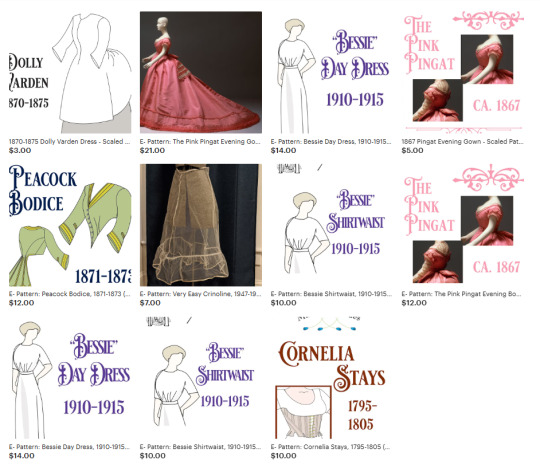
Just use the link, or you can manually put in the discount code: JUNE2025
218 notes
·
View notes
Text
I was angsting because due to the way Etsy weights/only counts recent reviews, my seller rating has dipped and as a result, I'm not making any sales. In order to perk things up (and hopefully get a few more, newer good reviews), I decided to run a promotion for the rest of the month!
See my shop here

Just use the link, or you can manually put in the discount code: JUNE2025
#historical fashion#fashion history#18th century#19th century#20th century#day dress#1910s#evening dress#1860s#regency
218 notes
·
View notes
Text
I feel like in 2005, this was such a shocking change from the norm of Austen adaptations (not necessarily accurate in material culture but giving the impression that it was all authentic because of all the faithful dialogue and the historic locations/set dressing) that it made sense for everyone to fixate on it, similar to the way that people fixated on Coppola's Marie Antoinette for its occasional deliberate anachronisms. I remember most or all of the Austen adaptations in that wave getting a kind of derisive reception for similar reasons. And then it all got solidified into meme status.
Ten years ago, I wrote blog posts on why 2005's costuming isn't that bad and why 1995's costuming is less accurate than you think, because I was so tired of the discourse and everyone pulling out 1813 fashion plates to compare it to. (And I still think I made a good point about windswept romanticism getting mocked in 2005 while 1995 was feted for the wet shirt scene.)
It's just that since then, everything's gotten so much worse! Every Georgian show/movie these days features cheaper, stripped-down, modernized costumes made with less care and intention. Why is anyone still complaining about it being 1790sish when "we're taking the book back to the decade it was written" is at least way more interesting than "we don't think viewers can care unless the costumes relate to modern sensibilities"?
The 2005 P&P is not remotely my favorite P&P adaptation, and is IMO more of an adaptation of pop culture-P&P in dialogue with other adaptations and films than directly one of the novel. But it's been 2 0 y e a r s and somehow every conversation about the costuming seems to devolve into scolding Joe Wright for presuming not to like 1810s fashion or want it in the adaptation.
Austen wrote Pride and Prejudice in 1796-1797. Her father tried to submit it for publication but was ignored. She revised it in the earlier 1800s, though we don't know what this consisted of beyond cutting out what sounds like pretty significant swaths of material (likely the reason for its especially smooth, balanced, tightly-paced structure—not that I wouldn't ritually sacrifice a puppy to get my hands on the passages she removed and undoubtedly destroyed). The manuscript was finally accepted, and published in January of 1813.
The sense of a cultural/atmospheric split between the revised early manuscripts (Northanger Abbey, Sense and Sensibility, and the jewel of this set, Pride and Prejudice) and the late Austen works that completely originated in the 1810s (Emma, Persuasion, Sanditon; MP is more ambiguous) is not unusual nor broadly controversial. The Chapman 1811-1812 calendar for P&P is possible (though no real year can be fully reconciled to the novel's internal calendar), but not the only possibility, nor necessarily even the most probable. Certainly no director or costume designer or anyone else is in any way obligated to replicate "the Regency" of popular consciousness—the Regency of Regency romances, of so many period Austen adaptations, the frozen eternal moment of the concept.
It's not that the costume choices are beyond criticism (I do think some choices are very 2005 beyond the necessity of speaking to a contemporary audience) but "Joe Wright didn't like 1810s fashion and yet made a period adaptation of a novel written in 1797, how dare" seems endlessly recycled and yet incredibly inane.
131 notes
·
View notes
Text
graaaaaaaaaa arguing with disingenuous idiots about corsetry again
13 notes
·
View notes
Text

Really excited to share with you all that the anthology By Her Sword, which includes a story of mine, is out!
My story, "Sisters in Arms", is told from the perspective of Leo, an ordinary guard to the queen, who simply can't understand why elite duellist Vell is always bothering her ...
Vell couldn’t have noticed that, of course. Nobody could feel an angry blink. But all the same, she fell into step with Leo as Dexamine went on ahead, ambling with her hands behind her back in a way that threw her coat away to reveal her sword’s filigree hilt. “Lovely day, isn’t it?” Leo snorted, despite her intent not to make a sound until the squad was out of the presence chamber. “It’s cloudy.” “But warm!” After that, Vell let her walk in merciful silence for the rest of the way out of the chamber. It didn’t last. “Do you know, I heard from the Countess di Barri that Count Femy is trying to buy up the entire market’s worth of pearls to make into a strand hundreds of feet long? She said he wants to give it to the queen to entice her into —” “You should spend less time gossiping with countesses and more time watching for threats to the queen.” It came out harsher than she meant, and Leo winced internally — she didn’t want to be cruel, just to make her priorities clear — but it didn’t seem to faze Vell at all, somehow. She actually laughed. “Count Femy having designs on influencing the queen with gifts is a threat, isn’t it?” The worst thing was that she was right. Leo was not about to admit that, though, and just sniffed.
... though they still manage to intercept and foil a plot on the queen's life.
Currently only available in hard copy or as a Kindle ebook, but eventually it will be out on other e-platforms!
23 notes
·
View notes
Text

Really excited to share with you all that the anthology By Her Sword, which includes a story of mine, is out!
My story, "Sisters in Arms", is told from the perspective of Leo, an ordinary guard to the queen, who simply can't understand why elite duellist Vell is always bothering her ...
Vell couldn’t have noticed that, of course. Nobody could feel an angry blink. But all the same, she fell into step with Leo as Dexamine went on ahead, ambling with her hands behind her back in a way that threw her coat away to reveal her sword’s filigree hilt. “Lovely day, isn’t it?” Leo snorted, despite her intent not to make a sound until the squad was out of the presence chamber. “It’s cloudy.” “But warm!” After that, Vell let her walk in merciful silence for the rest of the way out of the chamber. It didn’t last. “Do you know, I heard from the Countess di Barri that Count Femy is trying to buy up the entire market’s worth of pearls to make into a strand hundreds of feet long? She said he wants to give it to the queen to entice her into —” “You should spend less time gossiping with countesses and more time watching for threats to the queen.” It came out harsher than she meant, and Leo winced internally — she didn’t want to be cruel, just to make her priorities clear — but it didn’t seem to faze Vell at all, somehow. She actually laughed. “Count Femy having designs on influencing the queen with gifts is a threat, isn’t it?” The worst thing was that she was right. Leo was not about to admit that, though, and just sniffed.
... though they still manage to intercept and foil a plot on the queen's life.
Currently only available in hard copy or as a Kindle ebook, but eventually it will be out on other e-platforms!
23 notes
·
View notes
Text
Your stitchwork, sir!
I haven't really got many photos of me wearing the brown/gold silk waistcoat, so here is most of the wearing footage from the video, plus a tiny bit of the sewing footage. The full video is 52 minutes and I cover all the construction very thoroughly (excluding the buttons and buttonholes which I have separate tutorials for).
(Music is The Garden Repertoire by Francis Wells from Epidemicsound.)
363 notes
·
View notes